Something to Ponder . . .
What is the best thing for the EMC professional to do on a
hot summer day? This editor suggests that you grab an ice-cold
drink, relax in a shady spot and ponder a puzzling, unsolved
EMC mystery. Steve Jensen of Steve Jensen Consultants has
just such a ‘mystery’ that he has most graciously
shared with Chapter Chatter.
Chatter: Steve, please give our readers as many details about
this unsolved mystery as you can. We understand that it has
something to do with car keys?
Steve: Well sort of. The mystery, which I call the “key
chain effect” continues to cause problems for my clients
and me. Anyone can experience the ‘key chain effect’
first hand in the radiated emissions lab of his choice. One
has to simply put together a test setup that involves either
a rod antenna or the bi-conical dipole. Then, tune the receiver
(spectrum analyzer) to 25 MHz or thereabouts. Put the analyzer
on Max Hold and let it sweep continuously using “zero
span” and 10 kHz bandwidth. Next, a person needs to stand
about two feet from the antenna and jingle his car keys in
front of the antenna and watch what happens. The screen will
fill up with little spikes that appear to be impulses associated
with the collision of one key against another. These spikes
are typically above the MIL-STD-461 limit for RE102! I have
found this to be a significant problem when running EMI tests
on anything that vibrates. I have even experienced this effect
in certain shielded rooms where I discovered that some of
the bolts are not tightened properly. To see this phenomenon,
a person should provide the same test set-up described above.
Then she should go into the shielded room and stomp on the
floor. The results will be similar to that of the car key
jingling. I am confident that this is not ESD, as the effect
happens even when you are holding onto the keys. I don’t
have a scientific explanation for what is happening (yet);
I am hoping that some additional research will yield a solid
technical explanation for the “key chain effect.”
Chatter: Wow Steve, that sounds like a great EMC mystery for
our readers to chew on for the next couple of months. If any
of the Chapter Chatter readers have a good idea about the
“key chain effect,” can they send you an e-mail?
Steve: Certainly. I would welcome the input. Send an e-mail
to steve@stevejensenconsultants.com. |
Baltimore-Annapolis
Robert Berkovits reports that the EMC and ED/SSC Societies and
the Greater Baltimore Penn Alumni Club sponsored the September
meeting speaker, Dr. Arthur J. Epstein, a University of Pennsylvania
physics graduate, and Distinguished University Professor in the
Department of Physics and the Department of Chemistry and Center
for Materials Research at Ohio State University. Professor Epstein
is recognized as the world’s leading expert in how polymers
conduct electricity and he is a Fellow of the American Physics
Society. His presentation on September 25, 2003 was titled “Nanotechnology,
Plastics, and Your Investments.” The attendance was 55 people.
On Monday, 24 November 2003, Dr. Lothar O. (Bud) Hoeft, Consultant,
Electromagnetic Effects, and a former EMC Society Distinguished
Lecturer, spoke on “Experimental and Theoretical Analysis
of Electromagnetic Shielding of Cables and Connectors (Keeping
Currents/Voltages Where They Belong).” This was a joint meeting
with the APS/MTT Societies and was held at the Historical Electronics
Museum, Pioneer Hall, in Linthicum, Maryland where most of our
Chapter meetings are held near BWI airport. A total of 24 people
attended.
On Tuesday, May 4, Dr. Bruce Archambeault of IBM, Raleigh NC,
an EMC Society Distinguished Lecturer, gave a talk entitled “EMI/EMC
Computational Modeling for Real-World Engineering Problems.”
This was a joint meeting with the APS/MTT Societies and was held
at Northrop Grumman Electronic Systems Division in Baltimore,
MD. This was the first time the local Chapter set up a net meeting
with the Litton Division of Northrop Grumman in Woodland Hills,
CA. Dr Thomas Walsh of the AP Society, set up the full PC communications
link with voice to the off-site audience. The total attendance
was 57, with 46 in Baltimore and 11 Woodland Hills. Future plans
for the EMC Chapter are to have speakers addressing the issue
of broadband on power lines. This meeting will be a joint meeting
sponsored by several Societies in the Section and may feature
a panel discussion type format. Another meeting planned for the
Fall of 2004 will be on Systems EMC. The Chapter officers are
Robert Berkovits of Northrop Grumman ES Division as Chair and
John Anderson of Alion Science as Vice Chair.
Central New England
Jon Clarke reports that the Central New England EMC Chapter has
held one meeting since the Spring 2004 issue. On Wednesday May
5, 2004 a presentation was made by Distinguished Lecturer Bruce
Archambeault, Ph.D., Senior Member Technical Staff, IBM, NC. The
topic Mr. Archambeault covered was: “How to Avoid the Main
Cause of EMI Problems on Multi - Layer PCBs.” The speaker
discussed the main causes and problems produced by EMI on Multi
- Layer PCBs. Methods used to avoid these problems were also described.
26 individuals consisting of 16 IEEE EMCS members and 10 guests
attended the meeting. The Chapter has scheduled the next meeting
for Wednesday July 21st. The speaker will be Distinguished Lecturer
Professor Michel Ianoz who will present his topic “Lightning
Electromagnetic Effects.” This meeting was previously scheduled
for December 4, 2003 but had to be postponed due to illness of
the speaker.
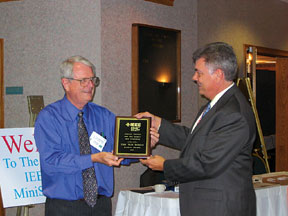 |
| Frank Krozel (right), Chicago MiniSymposium
Chairman (for last six or so years...who is counting?) presents
an award to speaker Tom Van Doren of the University of Missouri
at Rolla. |
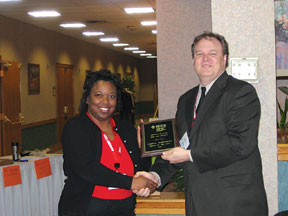 |
| Jack Black, Chicago Chapter Chairman,
presented an award to Carla Robinson, EMC Person of the Year!
Carla is from US Robotics and she attended the MiniSymposium. |
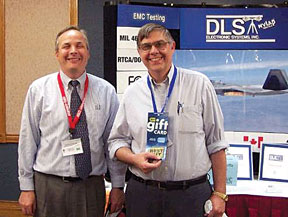 |
| Ray Klouda of Elite Electronic Engineering
and Steve Muchow, Shure, winner of the IEEE EMC raffle gift
certificate at the Chicago MiniSymposium. |
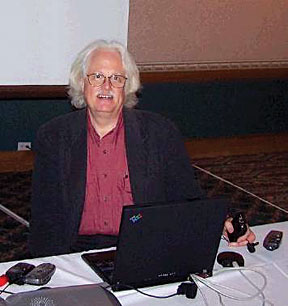 |
| Speaker Jim Brown of Audio Systems
Group, Inc. at the Chicago Chapter’s MiniSymposium in
May. |
Chicago
Frank Krozel reports that 2004 was the Chicago Chapter’s
best year yet for its annual IEEE EMC MiniSymposium. They had
new faces, a record turnout, and truly a great time at the 6th
Annual MiniSymposium! Vendor tables at the Chicago MiniSymposium
were sold out this year! “While I cannot say that the EMC
industry is coming back in Chicago, I am very encouraged by the
quality of the attendees. I look forward to 2005 with our MiniSymposium
(same place, same time, same people!), and……the 2005
IEEE International Symposium on EMC! Come to our beautiful and
entertaining Navy Pier in August! Experience the Energy - EMC
2005 CHICAGO!” says Frank Krozel, Chairman, Chicago Chapter
EMC MiniSymposium. See the Chicago Chapter website for more details
at https://emc2005.org/
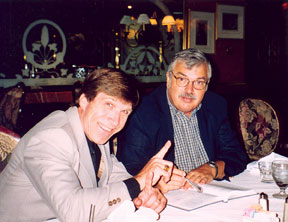 |
| A welcome dinner was held the evening
prior to the Dallas EMC Chapter’s Colloquium and Exhibition.
Jeff Tregre of Texas Spectrum Electronics (left) enjoyed the
opportunity to personally speak with Clayton Paul about his
new book, Electromagnetics for Engineers. |
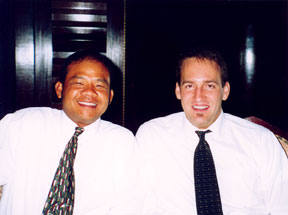 |
| Teng Tip and Mark Szewczul (right)
of Dallas Semiconductor and Dallas EMC Chapter Chair, enjoyed
the welcome dinner for Dr. Paul. |
 |
| Dallas EMC Chapter members busy networking
during the reception included (from left) Phillip Havens,
Robert Fort, Mark Szewczul and Jeff Tregre. |
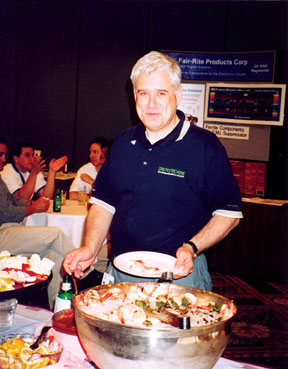 |
| Colin Brench of Hewlett Packard is
the most recent member of the Dallas EMC Chapter having moved
to Texas from Massachusetts. He enjoyed the jumbo shrimp during
the reception following Clayton Paul’s presentation. |
 |
| Austin Truit of Lockheed Martin dropped
by to visit with exhibitors Bob Ydens and Tom Koons of EMI
Solutions (from left) at the Dallas EMC Chapter Colloquium
and Exhibition. |
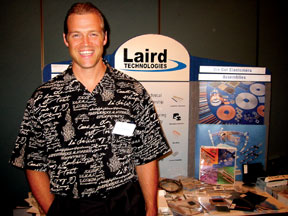 |
| Shelby Ball of Laird Technologies
thoroughly enjoyed the exhibition held during the Dallas EMC
Chapter event. |
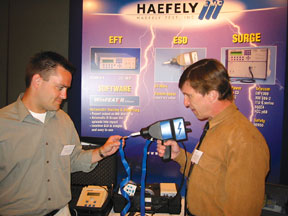 |
| Chris Faust of Haefely (left) provided
a product demonstration to Jeff Tregre during the Dallas EMC
Chapter Colloquium and Exhibition. |
Dallas
The Dallas EMC Chapter has been very active under the leadership
of Chair Mark Szewczul of Dallas Semiconductor. The monthly meetings
have been well publicized and well attended. Past speakers include
Dr. Vince Rodriguez of ETS-Lindgren and the famous Dr. Howard
Johnson. The Chapter recently held their first one-day colloquium
and exhibition. Mark Szewczul organized the event along with the
help of his Chapter and Section officers. The event was held at
The Richardson Hotel on June 14 with Clayton Paul presenting his
popular course, “The Fundamentals of EMC.” Some 60 people
attended. Over 20 exhibitors of EMC related products and services
were on hand to showcase their latest offerings, including locally
based Rohde & Schwarz, who donated a USB memory stick as a
raffle item to add a little excitement to the activities. Lunch
sponsors included exhibitors X2Y Attenuators and Leader Tech.
Reception sponsors included exhibitors AR Worldwide, Rohde &
Schwarz, Laird Technologies and Mentor Graphics. Dr. Paul’s
book “Introduction to Electromagnetic Compatibility”
was sold in conjunction with the registration and was an instant
best seller. He graciously stayed after the presentation to personally
autograph copies of his book for the registrants during the reception.
That autograph may well be worth something now that Dr. Paul is
the 2005 IEEE Electromagnetics Award winner! Even so, all valued
and appreciated the time spent with this noted educator and lecturer.
The Dallas EMC Chapter will long remember their day spent with
Dr. Paul. If you would like to attend a Dallas Chapter meeting,
please visit www.DallasEMC.org for more information.
Israel
On June 13th, the “Electromagnetic Influence (ELF) Basic
Exposure Limitations and Engineering Ramifications” conference
was held in Hertzelia near Tel Aviv, Israel. The conference was
organized by the Israel IEEE EMC Chapter, the Association of Electrical
and Electronic Engineers (IAEEE), and by the Association of Urban
Engineers in Israel. The number of participants in the conference
was over 220. The conference brought together the experts dealing
with EM radiation, environmental office personnel, and legislators
dealing with ecology preservation. The conference was an opportunity
for engineers, architects, and common citizens to clarify open
radiation safety questions, some of which have not been fully
addressed by the technical community. The speakers and a brief
description of each of their presentations follows: Dr. Stelian
Gelberg, Radiation and Audio Noise Commissioner, is best known
for his conservative approach to public exposure to magnetic fields
and radio frequency radiation. Dr. Gelberg explained the considerations
that led him to adopt a public exposure threshold, 1% of the threshold
recommended by the world health organization. His lecture emphasized
that there is no difference between the wide public exposure and
work-related exposure, excluding professions that require exposure,
such as electricians and antenna installers. Professor Leeka Kheifets,
Vice president of the World Health Organization (WHO) non-ionizing
radiation project, delivered the keynote lecture. Her lecture
included a thorough survey of the WHO recommendations on the issue
of public exposure to radio frequency (RF) radiation in general,
and to electromagnetic fields in the Extremely Low Frequency (ELF)
in particular. Dr. Eli Stern, the principle scientist of the environmental
office, recommended the adoption of the “prudential avoidance”
approach to the issue of public exposure, and expanded on the
regularity and application principles of exposure to electromagnetic
ionizing and non-ionizing radiation. In his lecture he brought
up examples of the ionizing standardization, characterized by
defining permissible exposure levels in relation to the duration
of exposure from a single device, a yearlong exposure term, and
a four-year exposure term. Professor Josef Ribak, head of Occupational
and Environmental Health and Public Health School, Tel Aviv University,
lectured about the lack of consensus concerning adverse affects
of non-ionizing radiation on public health, and the misconception
of risk by the public. Professor Ribak discussed the waste of
resources caused by the public fear of non-ionizing radiation,
whereas these resources are desperately required for dealing with
real and proven health threats. Mr. Oren Hartal, Rafael’s
chief scientist, presented the available engineering measures
and techniques for decreasing ELF magnetic field exposure levels,
following the recommendations of the environmental office, and
cost assessment of each solution. The lecture contained real life
examples of efforts that succeeded to decrease the magnetic fields
in public facilities and private homes by performing certain actions.
Avishai Rash, consulting engineer, presented “Authorized
and Unauthorized Radiation and Field Measurements.” Mr. Rash
pointed out the absence of law and ordinance regarding unauthorized
and unprofessional personnel who are conducting non-ionizing radiation
measurements with non-calibrated and inaccurate equipment. Dr.
Ehud Ne’eman, former head of the audio noise and radiation
department at the environmental office, approached the issue of
ELF magnetic field measurement, the abundance of cheap and imprecise
devices for radiation measurement, and the existence of common
measurement errors that might lead (even qualified professionals)
to false conclusions regarding the hazard of magnetic field sources.
Moshe Netzer, radiation safety engineer and chairman of the Israel
EMC Chapter presented the international standardization in ELF
electromagnetic exposure and the known physiological and health
effects of ELF field exposure. In his presentation, Mr. Netzer
presented a historic list of anxiety waves concerning radiation
from various appliances, waves that faded away when it was realized
that these fears have no real basis. Lastly, Dr. Yuri Stern, Knesset
member, covered the necessity to authorize radiation surveyors
by the National Lab Authorization of the Labor Office. He also
discussed the necessity to form a committee of experts that would
advise the Parliament Internal Affairs and Environmental Committee
in areas of legislation regarding public exposure to non-ionizing
radiation, including ELF fields.
Korea
Jong Hwa Kwon reports that there has been a change of leadership
in the Korea Chapter. Professor Jeong-Ki Pack was elected to a
two-year term as the Korea EMC Chapter Chairperson beginning January
1, 2004. Professor Pack received the B.E. degree from the Department
of Electronic Engineering from Seoul National University, in 1978.
He received the M.E. and Ph.D. degrees in electromagnetic wave
propagation from Virginia Polytechnic Institute and State University
in 1985 and 1988, respectively. Currently, he is a professor of
the Department of Radio Science & Engineering at Chungnam
National University. His research interests include wave propagation
and scattering, the biological effects of electromagnetic fields,
the design of microwave circuits, and EMI/EMC. This year, the
Korea EMC Chapter plans to jointly hold several meetings with
KEES (Korea Electromagnetic Engineering Society), including a
seminar on Antenna Technology in April, the EMC Korea Workshop
in September, and a workshop for “EMF Influence on Humans”
in October.
Mohawk Valley
The Mohawk Valley Joint EMC/Reliability Chapter hosted a Spring
meeting on May 13 with guest speaker Dr. Michael J. Gans of the
Air Force Research Laboratory in Rome, NY. Dr. Gans’ talk
was titled, “Some Effects of Mutual Coupling and Noise on
Channel Capacity Between Antenna Arrays.” It was an excellent
and informative presentation on the application of space-time
coding techniques to achieve very high spectral efficiencies in
highly scattering environments using multiple transmit and receive
antennas. Since the spectral efficiency improves with the number
of antennas, one is interested in how many antennas can be crammed
into a limited space according to Dr. Gans. Some of the issues
which affect the allowable density of antennas in the station
antenna array are (a) the mutual impedance between antenna elements
in the array, (b) the correlation between the signal and noise
fields received by these elements, and (c) amplifier noise contributions.
Dr. Gans pointed out that we tend to describe the impact of these
factors on the channel capacity achievable by such arrays. These
are useful considerations in terms of maximizing the number of
channels while at the same time reducing the potential for interference,
which is a challenging, but achievable goal. By the way, Dr. Gans
is one of the leading experts in multiple input multiple output
(MIMO) array technologies which exploit spatio-temporal diversity
and EM scattering properties of the local environment within which
the arrays operate. He was previously a member of the Wireless
Communications Research Department at Bell Labs in Holmdel, New
Jersey. He received his Ph.D. Degree in electrical engineering
from the University of California at Berkeley in 1965. Prior to
his current duties at the Air Force Research Laboratory, he was
at Bell Laboratories since 1966. His primary technical areas include
mobile radio, antennas, satellites, fiber optics, and infrared
communications. In 2001, he retired from Lucent Technologies.
Dr. Gans certainly brings a lot of experience to the Mohawk Valley
area according to EMC Chapter Chair Irina Kasperovich. Ms. Kasperovich
plans for future talks commencing again in the Fall of 2004 that
will address such topics as New Paradigms for Spectrum Management,
Product EMC Compliance, and Computational Electromagnetics.
Nanjing
Wen Xun Zhang, Chapter Chair, reports that the Nanjing EMC Chapter
has held a number of meetings this last Winter and Spring. On
February 26, 112 (wow!) attendees listened to a paper by Professor
Jin-Au Kong of MIT entitled, “Electromagnetics Conspectus.”
Two days later, on February 28, Y. Leonard Chow (University of
Waterloo, Canada) gave a presentation entitled “Design Synthesis
of Patch Antennas with Direct Feed” to 73 members and guests.
In April, the Nanjing Chapter was busy with two meetings and a
“Workshop of Microwave Energy Application Technology.”
The microwave energy workshop was held on April 15-16 with 85
members and guests attending. The Chapter meeting on April 1 was
headlined by with a presentation given by Dr. Lin-Ping Shen of
Apollo, Inc. Canada. His presentation dealt with “Modeling
and Design of Passive Photonic Integrated Circuits (PICs).”
The Chapter meeting on April 28 featured Professor Rui-Xin Wu
of Nanjing University. Professor Wu’s presentation was called
“Microwave Near-field Microscopy and Its Application.”
The Nanjing Chapter also had a busy May. On the 19th, Dr. Ji-Ming
Song of Iowa State University spoke on the topic: “Fast Algorithm
in Computational Electromagnetics.” Then, Ming-Chu Wu spoke
to the Chapter on May 20th regarding “Antenna Technology
for Modern Phased Array.” Both meetings were well attended
with 54 and 62 members and guests, respectively.
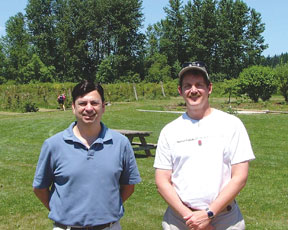 |
| Henry Benitez (left) and Dave Britton,
PSTC and EMC Chair Elects, at the Summer social of the Oregon
and SW Washington Chapter. |
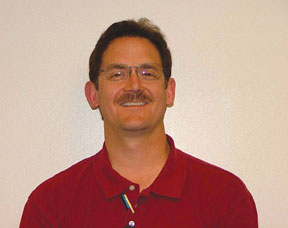 |
| David Britton of Hewlett Packard,
the new Chair for the Oregon and SW Washington Chapter. |
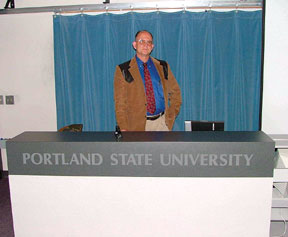 |
| Bill Parker of Parker EMC gets ready
for his May presentation to the Oregon and SW Washington Chapter. |
 |
| Mitchell Phillipi of Logitech, the
new Oregon and SW Washington Chapter Communications Director. |
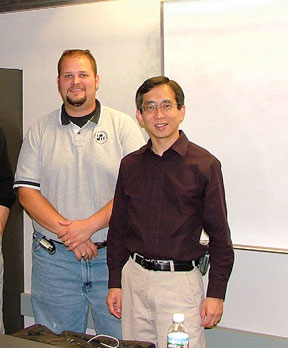 |
| Oregon and SW Washington Chapter
Immediate past Chair Derick Skouby and speaker Dr. CW Lam
from Apple at the April meeting. |
Oregon and SW Washington
David Britton, Vice Chair of the Oregon and SW Washington Chapter,
reports that during the April Chapter meeting, Dr. Cheung-Wei
Lam of Apple Computer presented “Common Misconceptions about
Inductance and Current Return Path.” The attendees enjoyed
a pizza dinner before the presentation. There were many questions
following. In May, the Chapter’s speaker was Mr. Bill Parker
of Parker EMC. His presentation was titled “30 Years of EMC
Field Testing.” Mr. Parker described several interesting
experiences he has had in his career. In June, the Chapter hosted
a summer social in conjunction with the Product Safety Technical
Committee. The members and their families met at Kruger Farms
on Sauve Island near Portland for a barbeque lunch and an opportunity
to pick all sorts of fresh berries. The group concluded lunch
with shortcake and strawberries fresh from the field. An election
was held prior to the May meeting. Nominations were solicited
at the April and May meetings. A new slate of officers was elected
for the 2004/2005 season. The newly elected officers are:
David Britton, Chapter Chair,
Hewlett-Packard Co.
Sidney Chan, Chapter Vice Chair, Hewlett-Packard Co.
Chuck Britten, Chapter Secretary,
JJ Associates
William Owsley, Treasurer,
Underwriters Labs
Aziz Inan, Chapter Membership
Director, University of Portland
Mitchell Phillipi, Chapter Communications Director, Logitech
The Chapter’s 2004 schedule is as follows:
• September
29th, 2004, Jerry Ramie will speak on “EMC Testing of Substation
Products”
• October 27th, 2004, Vic Clements will speak on “The
WEEE Directive”
• November 17th, 2004, Elya Joffe will speak on the subject
of “Electrophobia, or - Why Are People Really Scared of
Electromagnetic Fields”
• In December the Chapter will host a holiday social. Stay
tuned for more information.
For details on the above meetings and to RSVP, check our website
at: https://www.worldaccessnet.com/~emc/
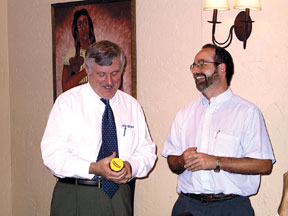 |
| After David Seabury’s presentation
to the Phoenix Chapter, Harry Gaul awarded him the customary
jar of salsa. Thanks to David for your informative presentation!
|
Phoenix
Glen Gassaway reports that Garcia’s Mexican Restaurant had
another packed house for the April 22nd IEEE EMC Society Phoenix
Chapter meeting. After a lively social hour (where the drinks
were on TMS’s tab - thanks Brent!), Harry Gaul was finally
able to calm everyone down and get to business. Harry reviewed
a schedule of upcoming meetings, including inviting Bill Parker
in the fall for a thorough review of EMC ‘war stories’.
Daryl Gerke may also be an upcoming presenter (stay tuned). Finally,
the Chapter intends to host a one day colloquium on antennas in
January or February. There’s more to come, too! Possibly
in light of a strengthening economy, the standard call for EMC
employment went unanswered - does that mean everyone is gainfully
employed? Harry then introduced our featured presenter, David
Seabury, a Senior Business Development Manager with ETS-Lindgren.
David gave a presentation entitled: “A Review of Radio Frequency
Exposure Requirements of FCC OET65 and the Latest Direction of
the IEEE/IEC Standards.” David explained that there are two
predominant RF exposure mechanisms that have enforceable standards
in the US, including “Maximum Permissible Exposure”
(MPE) and “Specific Absorption Rate” (SAR). The FCC’s
Office of Engineering and Technology (OET) Guidelines described
in OET-65 Ed 97-01 addresses both mechanisms. MPE typically refers
to the operation of RF-emitting devices in the far field (>20cm
distances) whereas SAR applies to devices within 20cm of the body.
MPE also allows either measured or predicted assessments, whereas
SAR almost always requires measured assessments. Control methodologies
for MPE involve a variety of options, including limiting output
power, time averaging, shielding, antenna pattern management,
or (the most popular) implementing personnel access restrictions,
including adding signs or fences. Enforcement of MPE standards
is increasing, with more actions and on-site reviews taking place.
In addition to the FCC, OSHA also enforces MPE limits, focusing
on the workplace. OSHA has by and large adopted the OET-65 limits,
but also addresses induced currents and covers a lower frequency
range. Key websites include www.fcc.gov/oet/rfsafety and www.osha.gov/SLTC/radiofrequencyradiation.
In the United States, SAR regulations are covered by FCC OET supplement
C 01-01. It indicates the applicability of the 20cm rule - where
the fixed, mobile or portable device has to be operated within
20cm of a human for the rules to apply. Europe’s near equivalent
standard is EN50630/50631 and most countries use the self-certification
method of compliance. Test methodologies for SAR include setting
the device under test at the highest RF power and probing localized
temperature rises in a ‘liquid’ phantom (head) or box
(body). A signal generator and coupler are typically used for
pretest calibration checks and the tests are normally done in
an automated fashion, using a robotic arm for probe positioning.
The talk concluded with an update of the work being performed
in the standards committees and the potential impact to the FCC’s
requirements. Information on future meetings is available on the
Phoenix EMC Chapter Web site at https://www.ewh.ieee.org/r6/phoenix/phoenixemc/.
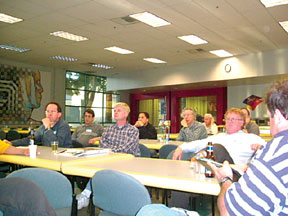 |
| An attentive group listens to Jerry
Ramie’s April presentation to the Santa Clara Valley
Chapter. |
 |
| Jerry Ramie of ARC Technical Resources
is shown during his April presentation on EMC testing of substation
products to the Santa Clara Valley Chapter. |
 |
| Neven Pischl’s presentation
on Ethernet was supplemented with this fascinating magnetics
demonstration at the Santa Clara Valley Chapter meeting. |
 |
| The Santa Clara Valley audience is
captivated by Neven Pischl’s Ethernet magnetics presentation
in May. |
Santa Clara Valley
The Santa Clara Valley Chapter continued its monthly technical
presentations during the early part of 2004. This year there were
several informative technical presentations. Attendance, in general,
was good, with 67 attendees, including 19 non-Chapter guests,
at the January meeting. As an added treat, hot tamales supplemented
refreshments at Chapter meetings. Monthly Chapter Administrative
Committee meetings were held, as well. At the January Chapter
Meeting, Mr. Orin Laney, Kaiser Electronics EMC and Signal Integrity
Specialist, made a presentation entitled “Time Domain Reflectometry
as an EMI Analysis and Troubleshooting Tool.” The presentation
covered time domain reflectometry theory, and there was a demonstration
illustrating TDR principles, with measurements of coaxial cable,
RG-178, waveguide, microstrip, and LAN cable. Also discussed were
the care, handling, and challenges encountered with microwave
rate bit streams. Mr. Laney has a B.S.E.E. and an M.B.A., and
is a NARTE Certified EMC Engineer (N.C.E.). At the January meeting,
Mr. Mike Heckrotte announced two open technician positions at
Compliance Consulting Services. In his capacity as Vice Chair
of the EMC 2004 Symposium Committee, Mike also announced the need
for exhibitors and volunteers for the IEEE International Symposium
on EMC in Santa Clara, August 2004. In February, Mr. Werner Schaefer,
Cisco Systems Quality Manager and Senior Compliance Engineer,
presented “Signal Detection with EMI Receivers.” He
discussed how scanning receiver sweep times and stepping receiver
dwell times affect the intercept of broadband and narrow-band
signals. Other topics were the interpretation of receiver display
test results, metrological limitations of test equipment, the
nuances of receiver detector modes, receiver display detection
mode usage, sampling at predetermined frequencies, the advantages
of positive peak detection over sampling with very wide test frequency
spans, frequency versus receiver display resolution on signal
detection, CISPR 16-1-1 EMI receiver specifications, including
dynamic range, different CISPR 16-1-1 receiver IF detectors, the
relevance of IF bandwidth, and the proliferation of digital IFs
in receivers and spectrum analyzers. Mr. Schaefer is the Chairman
of CISPR/A/WG1 and an NARTE certified engineer. The March meeting
started on a sad note, with a memorial for our well-known and
beloved colleague, Mr. Chris Kendall of C.K.C. Laboratories, given
by Mr. Hans Mellberg. There was a moment of silence, and then
words in memoriam were also offered by Darryl Ray, Robert Steinfeld,
and Mark Montrose, who, for a moment, brought back to us, “the
good times” with Mr. Kendall. The technical component of
the March meeting was kicked off by Mr. Leslie Bai, Director of
Certification at SIEMIC, Inc., in a presentation titled, “Assessment,
China Conformity: Issues Facing Companies in the China Market.”
This talk cleared up some of the mystery and political ramifications
of the Chinese culture and its potentially lucrative telecommunications
market, and addressed the regulatory and compliance challenges
facing western companies in seeking footholds in this market.
Mr. Bai, fluent in several foreign languages, addressed how different
Chinese government agencies administrate the Chinese Product Assessment
system, certification systems, and different government agencies
(CCC, NAL, RTA and MPS). He also gave us a bit of China Product
Conformity history and projections for future markets, and ended
the meeting with an informative Q & A session. Mr. Bai holds
an MSEE, and is a NARTE Certified Engineer. In April, Mr. Jerry
Ramie, President, ARC Technical Resources, Inc., presented on
“Electromagnetic Compatibility Testing of Substation Products,”
and the EMC testing requirements for products that are installed
in American or European Generation or Substation plants. The EMC
Standards for Substations, including CIGRE 36.04, NEMA ICS-1,
IEEE C37.90.X, IEC 60255-X, and IEC 61000-6-5 were discussed.
Mr. Ramie also covered EMC and testing for the Resistance to Sabotage
in Protective Relays. As the utility products market shows tremendous
growth potential, manufacturers will need to know these standards.
This discussion offered recommendations for Power Providers. This
fast-paced and brief presentation, which included hundreds of
slides, allowed a lengthy question and answer period afterwards.
Mr. Ramie is a long-time member of the IEEE EMC Society and is
also a member of the dB Society. In May, Mr. Neven Pischl, Broadcom
Principal Engineer, gave a presentation on the subject of “EMI
Considerations in the Selection of Ethernet Magnetics.” The
talk was on magnetics used on the WAN-side of Ethernet transceivers.
Among subjects covered were the nuances of characterizing EMI
properties of Ethernet magnetics, from datasheets, and the factors
that define these properties in magnetics used in common systems-level
configurations. Mr. Pischl has an MSEE and is a NARTE Certified
Engineer. Several very good metrological experiments were made,
including overhead projection of dual real-time measurements,
facilitated by a colleague of Mr. Pischl’s.
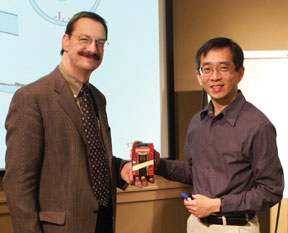 |
| Pat André (left) presented
“Seattle’s Best” coffee as a speaker gift to
C. W. Lam following his presentation to the Seattle EMC Chapter
in April. |
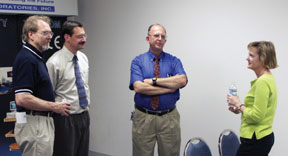 |
| Enjoying the “war stories”
at the May Seattle Chapter meeting are (from left) Leo Smale
of Lionheart Northwest, Pat André of André Consulting,
speaker Bill Parker with Parker EMC Engineering and Janet
O’Neil with ETS-Lindgren. |
Seattle
The April Chapter meeting featured the return of Cheung-Wei Lam
of Apple Computer. The Chapter was fortunate to have Dr. Lam as
a speaker last year when he was Distinguished Lecture of the EMC
Society. He was brought back by popular demand! The Chapter especially
appreciated this as Dr. Lam is busy these days as a member of
the steering committee for the 2004 IEEE International Symposium
on EMC in Santa Clara, California. Together with Bob Steinfeld,
also of Apple Computer, they are overseeing the experiments and
demonstrations presented during the Symposium. Dr. Lam’s
presentation lived up to his prior level of excellence and he
did not disappoint those who came to hear the topic “Common
Misconceptions about Inductance and Current Return Path.”
Dr. Lam explained how, in today’s high-speed digital system
design, a good understanding of inductance and current return
path is important to signal integrity and EMI control. Unfortunately,
several key concepts about the two have often been misunderstood
or overlooked. His presentation discussed the key concepts and
some common misconceptions about inductance and current return
path. This was supplemented by many educational examples at the
chip and PCB levels. The meeting was held at Microsoft in Redmond,
thanks to the efforts of Microsoft’s Gene Obie. Following
the meeting, Chapter Chair Pat André made a quick getaway
to Disney World for a much-deserved vacation with his family!
In May, the Chapter met at CKC Labs in Redmond. The first order
of business was the election of Chapter officers for 2004/2005.
Re-elected were Pat André, Chair, Janet O’Neil, Vice-Chair,
and Stephen Stimac, Secretary. Leo Smale of Lionheart Northwest
was newly elected as Treasurer. The meeting’s speaker was
Bill Parker of Parker EMC Engineering who treated the Chapter
to a unique presentation entitled “Down Memory Lane: 30 Years
of EMI Field Testing.” It was humorous as well as educational
to see how far we’ve come in this area. There were great
photos of Stoddart EMI meters, Hughes TWT Amplifiers, Singer System
VII EMI meters, and the nostalgic Genisco Technology Corporation
EMI test van. Have you ever thought about how the Aurora Borealis
can affect test site conditions? Well, this presentation covered
this topic and more. In summary, despite significant unplanned
events and conditions, the Chapter learned that “with proper
planning and execution, EMI testing can be productive, challenging,
rewarding and fun.” It was a light-hearted presentation to
end the technical program year. The Chapter will take the summer
months off and many members will travel to relatively nearby Santa
Clara, California for the IEEE EMC Symposium in August.
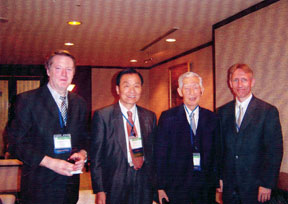 |
| VIPs at the EMC Sendai Symposium
included (from left) Dr. Alexander Worshefsky from Russia,
Professor Yougang Gao from China, Professor Risaboro Sato
from Japan, and Professor Todd Hubing from the USA. |
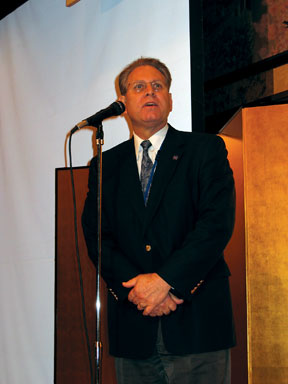 |
| Kimball Williams, President of the
IEEE EMC Society, addresses the audience at the Sendai 2004
EMC Symposium. |
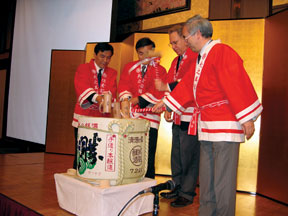 |
| The Sendai Symposium featured a traditional
“open sake” ceremony with a special barrel performance.
Sake is a well-known Japanese liquor. |
Sendai
The 2004 EMC Symposium at Sendai was held starting June 1 for
4 days. The Sendai EMC Chapter, the Japan EMC Chapter, the IEEE
EMC Society and the IEEE Sendai Section presented the event. Professor
Akira Suigura (Vice-Chairperson of the Sendai Chapter) presided
over the Symposium organization committee. EMC’04 Sendai
was a great success. Almost 500 participants from more than 20
countries attended. 226 technical papers were presented. The workshop
and the tutorials were very well received by the attendees. Exciting
social events (banquet, excursion, tea ceremony and flower arrangements)
also took place during the Symposium. The Risaburo Sato Award
was established and it was awarded by Professor Sato (the former
chairperson of our Chapter). Professor Takagi (Sendai Chapter
chairperson) presented the excellent student awards, which were
financially supported by the Japan and Sendai Chapters. Professor
Sugiura presented the Excellent Awards for the people who outstandingly
contributed to the EMC fields. The Sendai Chapter is now planning
to hold “The EMC Colloquium in Sendai” on a quarterly
basis.
 |
| Singapore Chapter members and guests
listen intently at the “EMI/EMC Evaluation Standards
and Test Measurements” short course presented by Dr.
Alphones (standing, far right). |
Singapore
Tim Foo reports that the Singapore Chapter presented their first
one-day colloquium on the subject of Printed Circuit Board Design
on June 11. The event was held in conjunction with Mentor Graphics
and the Institute of High Performance Computing (IHPC) at the
IHPC Auditorium. The theme of the colloquium was “Removing
the Black Magic: Designing PCBs to meet EMC Requirements.”
A total of 65 members and their guests attended the event. It
gave an opportunity for engineers from diverse industry backgrounds
to meet and get together. This colloquium presented four technical
sessions for engineers dealing with designing PCBs to meet international
EMC regulations. Several participants came from Penang, Malaysia.
The topics covered regulatory issues, appropriate use of CAD tools
and some practical findings related to EMC and ground bounce.
Bill Hargin (Mentor Graphics Corporation) spoke on “Multi-Gigabit/SERDES
Design and Controlling Emissions by Minimizing Unintentional Common
Mode PCB Currents.” Timothy Foo (Ngee Ann Polytechnic, Singapore
Chapter Secretary) spoke on the changing landscape of International
EMC regulations. Dr Lee, ErPing (IHPC, Chapter Deputy Chair) introduced
the EMC Consortium of Singapore to the participants. Dr. See Kye
Yak (Nanyang Technological University (NTU), Chapter Chair) spoke
on “The Correlation of Ground Bounce and Radiated Emission.”
On June 24th and 25th, the Chapter held a two day EMC measurement
short course taught by Dr. Alphones (NTU, Senior Member of the
IEEE) entitled “EMI/EMC Evaluation Standards and Test Measurements.”
The short course was held at the Holiday Inn Park View, Singapore.
A total of 21 members and supporters of the Chapter took part
in this event. The response was heartening and the Chapter will
seek to organize further short courses to meet the needs of the
industry. Interested parties please contact Tim Foo at fwj@np.edu.sg.
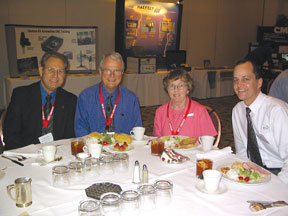 |
| Lunch time during EMC Fest 2004 provided
the opportunity for a little socializing and relaxation for
Kimball Williams of UL, Tom Van Doren and his wife, Lana,
and Steve Laya of Elite Electronic Engineering (from left).
|
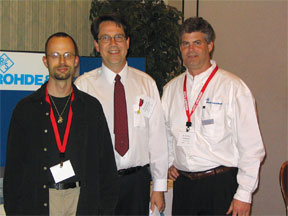 |
| Vic Hudson of Rohde & Schwarz
(right) drew the winning card of Andre Payant of Siemens (left)
during the EMC Fest raffle for a USB flash memory stick they
donated. Scott Lytle was there to hold the bowl and announce
the winner. |
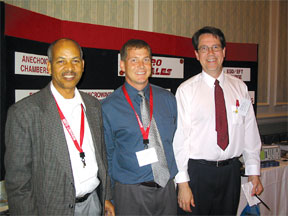 |
| A raffle was held during the reception
following the technical presentation by Tom Van Doren at EMC
Fest 2004. Iskias Naizghi of Yazaki North America (left) won
a Home Depot gift certificate from Sam Newman of Micro Sales
(center) who drew the winning card from Scott Lytle (right). |
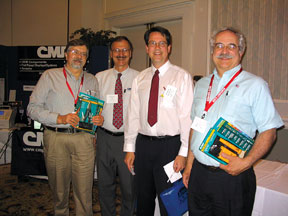 |
| EMC Fest Exhibitor CMP participated
in the raffle by donating multi-purpose tools. The winners
included Guy Gillespie from Hummer (far left) and Bill Gilmore
of DaimlerChrysler (far right). CMP’s Paul Huyck and
SE Michigan Chapter Chair Scott Lytle are all smiles during
the festivities. |
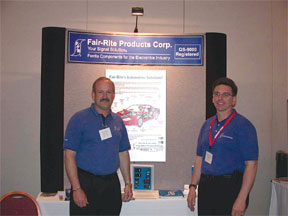 |
| Fair-Rite Products Corporation participated
as an exhibitor at EMC Fest 2004 in Dearborn. John Horner
(left) and Paul Zdanowicz staffed their tabletop display. |
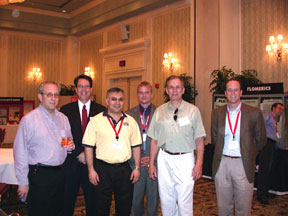 |
| It’s break time! Enjoying a
pause in the action are (from left) Mark Steffka of GM, Scott
Lytle of Yazaki North America, Jim Muccioli of X2Y Attenuators,
Phil Dew of Delta Technology Solutions, Tom Faro of Urban
Associates and Kevin Baldwin of ETS-Lindgren. |
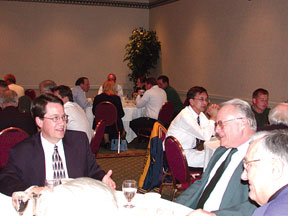 |
| The Southeast Michigan Chapter held
a dinner the night before EMC Fest 2004 to celebrate the arrival
in town of speaker Tom Van Doren. Several Chapter members
attended, including Chapter Chair Scott Lytle (left) as well
as Ken Musil and exhibitor Tony Anthony of X2Y Attenuators
(far right). |
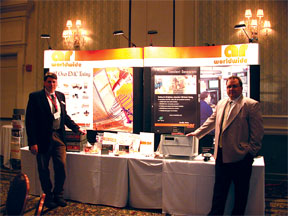 |
| AR Worldwide brought along two tables
of products and literature to EMC Fest 2004. Jason Smith of
AR Worldwide (left) and Larry Sheridan of Delta Technology
Solutions are there ready to provide customer assistance. |
Southeastern Michigan
EMC Fest 2004 proved to be a very popular
event with the members of the Southeastern Michigan EMC Chapter.
This event was held on May 6 at the Dearborn Inn in Dearborn.
The speaker was the popular and energetic Tom Van Doren of the
University of Missouri at Rolla. Dr. Van Doren presented “EMI
Coupling Mechanisms and Diagnostic Techniques” to a full
house of over 100 Chapter members and guests. He explained how
reducing electromagnetic interference (EMI) involves a thorough
understanding of what path currents take, what are self and mutual
inductance, how to contain electric and magnetic fields, and the
reasons for grounding electrical circuits. He addressed incorrect
concepts, such as: currents go to ground taking the path of least
resistance, a single straight wire has self inductance, and the
reason for grounding is to return currents to their sources. These
are the cause of many EMI problems! Most engineers and technicians
using or designing electronic systems have not had any formal
education concerning electromagnetic compatibility (EMC) principles
and design techniques. Learning how to solve EMC problems on the
job can be very expensive for the employer and frustrating for
the engineer. Dr. Van Doren showed how most of the electromagnetic
and circuit principles involved are very simple. He provided solutions
that engineers in attendance could use on the job the very next
day! Kimball Williams of Underwriters Laboratories, Mark Steffka
of General Motors, Janet O’Neil of ETS-Lindgren, and Chapter
Chair Scott Lytle of Yazaki North America ably coordinated the
event. Dale Sanders of X2Y Attenuators was on hand to take photos
of the event for publication in the EMC Newsletter and for posting
to the Chapter’s website www.emcsociety.org. 23 exhibitors
of EMC related products and services filled the ballroom adjacent
to the technical presentation classroom, including locally based
Micro Sales, Dytec/East, and CMP. Lunch sponsors included exhibitors
Fair-Rite Products, X2Y Attenuators, Lehman Chambers, and Mentor
Graphics. Reception sponsors included exhibitors AR Worldwide
and Rohde & Schwarz. Dr. Van Doren’s presentation was
well received and the Chapter sincerely appreciated the time he
spent coming to Michigan along with his lovely wife Lana. His
expertise will not long be forgotten! The Chapter is now busy
preparing for a one and a half day workshop on reverberation chambers
to be presented on September 14 and 15 at EST in Plymouth, Michigan.
Speakers for this workshop include Sean Emerson of Rohde &
Schwarz, Garth D’Abreu of ETS-Lindgren, Laura Ball and Kevin
Pender of General Motors, and Terry North and Andrew Shune of
DaimlerChrysler. Of course, no gathering on reverberation chambers
would be complete without industry expert Mike Hatfield of the
Naval Surface Warfare Center in Dahlgren, Virginia so he will
be on hand to lead off the presentations and provide the closing
summary. For more information on this workshop and the many activities
of the Southeastern Michigan EMC Chapter, be sure to visit their
website www.emcsociety.org often! Also, keep in mind that the
Chapter is regularly meeting to plan for the 2008 IEEE International
Symposium on EMC in Detroit. Many Chapter members will actively
participate on this Symposium Steering Committee. Downtown Detroit
is enjoying a “Renaissance Renovation” so it’s
an exciting time to bring an international Symposium to this city!
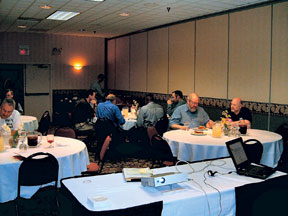 |
| Twin Cities Chapter members enjoy
their meal before Greg Kiemel’s June presentation on
wireless approvals. |
 |
| Curt Sponberg of Medtronic: Up close
with the past chair of the Twin Cities Chapter. |
 |
| Dan Hoolihan of Hoolihan EMC Consulting,
Twin Cities Program Chair and Treasurer, Greg Kiemel of Northwest
EMC, EMCS Distinguished Lecturer, and Joel Peltier of Medtronic,
the recently elected Twin Cities Chapter Chair. |
Twin Cities
Curt Sponberg reports that the Twin Cities held a Chapter meeting
in June that was highlighted with an outstanding presentation
by EMC Society Distinguished Lecturer, Greg Kiemel. Mr. Kiemel,
Director of Engineering at Northwest EMC, focused his presentation
on “EMC Authorization of Wireless Devices in the US and EU.”
In addition to the technical presentation, the meeting also included
the induction of the new Chapter officers. The new chairman, Joel
Peltier, was welcomed into office by the outgoing chair (for six
years!), Curt Sponberg. Other new Twin Cities officers are Brody
Pedersen, vice-chair; Terrence Brown, secretary; Curt Sponberg,
membership chair and Webmaster.
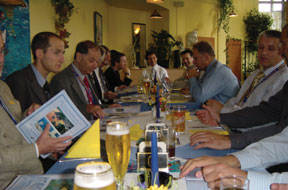 |
| One large table fits not all. But
can you spot our EMC Society President Kimball Williams? |
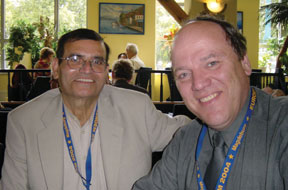 |
| IEEE German EMC Chapter Chair Heyno
Garbe (right) and Dave Giri have time for a relaxed smile
while entering a discussion at the end of lunch. |
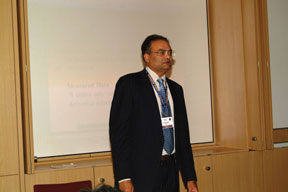 |
Professor Tapan K. Sarkar first delivers
an impressive
presentation... |
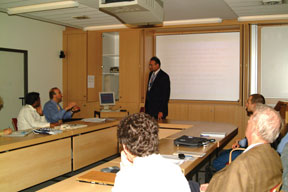 |
| ... and answers many questions in
a patient and pedagogical way. |
Germany
Meetings of the IEEE German EMC Chapter usually are a matter of
the brain and not for the body. They take place in serious conference
or seminar rooms and serve to discuss scientific and administrative
topics. But why not go for a change? Since the EUROEM 2004 took
place in Magdeburg, Germany, it was decided to embed a chapter
meeting into the conference schedule and simply turn it into an
extended lunch. The greek restaurant “Korfu” was chosen
and announced as the meeting place. And, indeed, the announcement
attracted, and not repelled, more than 30 members of the chapter
and international guests for the meeting and the good food. It
was the first IEEE German EMC Chapter meeting with three international
members of the EMC Society Board of Directors present. And while
it might not deserve mentioning, in spite of the informal atmosphere
and the diversity of attendees, many facets of EMC were indeed
the main topics discussed in between drinks of Ouzo and a delicous
mixed grill.
Nevertheless, during EUROEM 2004, an IEEE Region 8 Workshop on
Numerical Field Computation was arranged and conducted by the
IEEE German EMC Chapter; this time with no plates on the tables.
The Chapter was proud to be able to present Tapan K. Sarkar as
the invited speaker. Radiating an atmosphere of decades of scientific
experience, Professor Sarkar provided a detailed and excellent
presentation on applications of the principle of analytic continuation
in computational electrodynamics. The workshop was completed by
Arnulf Kost, Dieter Stoll, and Marco Leone, members of the Working
Group on Numerical Methods of the Chapter. They outlined EMC-benchmark
examples for the validation of numerical field-simulation methods.
Solutions of these examples get more and more refined and serve
as useful validation tools for the Chapter members and other interested
scientists. EMC
|
|
|
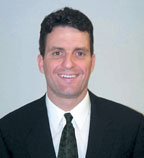 Chapter
Chatter
Chapter
Chatter